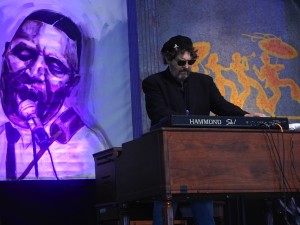Organ and piano player Marc Adams has seen a lot change in the nearly four decades he’s been behind the keyboard, and he has taken full advantage of each technological advance that has come his way.
Adams has spent the past 15 years accompanying Eric Lindell both in the studio and on the road, and in that time he has watched the steady tide of technology take the sound of his beloved Hammond B3 organ to places he would never expect.
The biggest advantage has been the drastic reduction in both size and weight of keyboards capable of replicating the B3’s signature sound without having to haul around the hulking 350 pound vintage instrument on tour, especially since any bump or rattle can knock something out of place.
“It takes such maintenance to keep a B3 and a Leslie amp working properly,” Adams said. “There are so many things that can go wrong. If you take the back off of an organ, it looks like spaghetti back there with all the wires and motors and tone wheels and belts and all those kinds of things. With the electronic instruments, you don’t have those types of problems.”
Not comfortable with having to adjust his playing to fit the loose wires and idiosyncrasies of house organs at live venues and recording studios, Adams turned to his trusty Hammond electronic keyboard that Lindell dubbed his “little red rocket.”
“Thirteen years ago, David Tarantolo, ‘the Organ Doctor,’ sold me a Nord Electro 2, which totally blew my mind,” he said. “The organ and the clavinet and the pianos and all those things were just so amazing. It’s 61 keys, which is the same size as a Hammond Organ, and it only weighed 15 pounds. I was like the first one in town that started playing it.”
With an approximately 95 percent decrease in weight and solid reliability, Adams said he was hooked. Until Tarantolo upped the ante earlier this year when he asked Adams to try out some new Hammond products.
“I tried this new keyboard, the Hammond SK-1, and it’s got everything the Nord’s got and then some,” he said. “And it’s like 14 pounds.”
Technology has advanced again as the weight has decreased.
“On the clavinet patch, it converts your volume pedal to a wah-wah pedal,” Adams said. “I think that’s pretty amazing, and it’s got all the other little perks that Hammond organs have like reverb and things like that.”
But the same music purists who prefer vinyl records over digital files and vintage instruments over anything new must be on to something. The sound has to suffer, right? Adams doesn’t think so.
“I think it’s like we get better old sounds,” he said. “I know a lot of people like these little quirks of these organs – this little buzz or this little thing here and there – but I’ve learned to appreciate the clean sound. If I want to dirty it up some, I can do that easily.”
Having watched the use of the original B3 organ give way to Fender Rhodes piano in the 70s, then synthesizers in the 80s, before electronic keyboards with B3 sounds swept back into vogue, Adams tends to favor logistics over sentimentality.
“If I had the right case, I could carry my new keyboard on an airplane and put it in a luggage rack above my head,” Adams said. “We played up in New York, and we were cabbing it all over the place. I had the little SK-1 under my arm, and we’d just throw it in the cab and go. There really aren’t that many places you can’t go with it anymore, and then when you get there, you’ve got that B3 sound.”
Editor’s Note: Tech Talk is an occasional series focused on the technical aspects of making great music designed to shed some light on the people behind the scenes.




